Implementing An IPM Program Between Hispanic Landscape Management Companies (Part 2 - Year 2008)
Project description and objectives:
According to a 2005 University of Florida Nursery and Landscape Industry Economic analysis report Florida’s landscape sector accounts for 5.255 billion 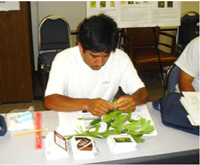 dollar sales a year. Almost 50% is related to landscape maintenance, design and other businesses. In Florida the statistics said that one new pest arrives every month causing huge economic impacts. The use of IPM principles to minimize pests and apply chemicals only when appropriate is a key concept for a sustainable environment. Traditionally, the majority of Extension landscape management programming and educational publications available on Integrated Pest Management (IPM) topics have been produced and directed towards English speaking audiences. However, in Florida, a demographic change has rapidly occurred where the Hispanic speaking audiences make up twenty percent of the overall population, according to the 2006 US Census Bureau.
dollar sales a year. Almost 50% is related to landscape maintenance, design and other businesses. In Florida the statistics said that one new pest arrives every month causing huge economic impacts. The use of IPM principles to minimize pests and apply chemicals only when appropriate is a key concept for a sustainable environment. Traditionally, the majority of Extension landscape management programming and educational publications available on Integrated Pest Management (IPM) topics have been produced and directed towards English speaking audiences. However, in Florida, a demographic change has rapidly occurred where the Hispanic speaking audiences make up twenty percent of the overall population, according to the 2006 US Census Bureau.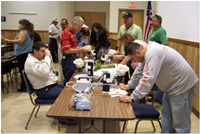 Although in the landscape business, the percentage of Hispanic speaking people is higher. In Miami-Dade approximately sixty percent of the landscape work forces speak Spanish, in Fort Pierce between 14-20 percent, and in Duval between 5-10 percent. The purpose of this project is to introduce the use of the IPM Scouting Kit to educate the growing numbers of urban Hispanic landscape personnel. The Spanish IPM Scouting Kit will be a multi-county effort between Duval, St. Lucie and Miami-Dade County Commercial Extension agents.
Although in the landscape business, the percentage of Hispanic speaking people is higher. In Miami-Dade approximately sixty percent of the landscape work forces speak Spanish, in Fort Pierce between 14-20 percent, and in Duval between 5-10 percent. The purpose of this project is to introduce the use of the IPM Scouting Kit to educate the growing numbers of urban Hispanic landscape personnel. The Spanish IPM Scouting Kit will be a multi-county effort between Duval, St. Lucie and Miami-Dade County Commercial Extension agents.
Project activities:
This project was a continuation of last year’s training. We used the IPM toolkit that was created last year. The toolkit contains the following materials: briefcase middle size, hand pruner, magnifier 10X, latex gloves, pen, permanent marker, 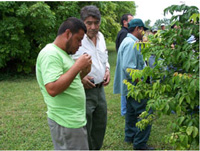 pencil, ruler, sample bag 6x9 and 4x6, and polystyrene collection jars. It also includes reference materials such as: UF card deck Disorders and Diseases of Ornamental Palms (SP360), Helpful, Harmful or Harmless (SP130) and Troubleshooting Lawn Pests (SP180), a weed identification insert about the most documented weed problems in Florida landscapes and a disease, insect and weed survey scouting sheets. All these materials were translated into Spanish with the assistance of specialist and county faculty who speak Spanish.
pencil, ruler, sample bag 6x9 and 4x6, and polystyrene collection jars. It also includes reference materials such as: UF card deck Disorders and Diseases of Ornamental Palms (SP360), Helpful, Harmful or Harmless (SP130) and Troubleshooting Lawn Pests (SP180), a weed identification insert about the most documented weed problems in Florida landscapes and a disease, insect and weed survey scouting sheets. All these materials were translated into Spanish with the assistance of specialist and county faculty who speak Spanish.
Upon completion of the written translations, Power Point presentations were also converted from English to Spanish. These presentations included information on how to use the IPM Scouting Kit, Integrated Pest Management Principles, and Diseases and Disorders of Palms and other Landscape Plants.
Upon completion of converting the IPM materials from English to Spanish, landscape companies were selected then presentation times and dates were 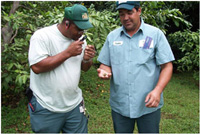 established. The IPM grant team determined that the presentations were to be delivered in three individual counties ranging from Miami – Dade up the coast to St. Lucie and continuing on into Jacksonville in Duval County.
established. The IPM grant team determined that the presentations were to be delivered in three individual counties ranging from Miami – Dade up the coast to St. Lucie and continuing on into Jacksonville in Duval County.
Forty-eight participants were selected, and the toolkit materials were distributed among them. The six hour program consists of presentations and indoor activities during the morning followed by outdoor exercises during the afternoon. The presentations include: Basic IPM Principles, Insect and Diseases, and IPM Toolkit Use. The delivery of the programming was enriched by numerous physical samples of insect and disease problems strategically located through-out the classroom, the use of a stereoscope, and the QX5 computer microscope for proper pest identification. The morning classroom activities were reinforced by field exercises in the afternoon when IPM students were provided an opportunity to use the IPM tool box first hand.
Project accomplishments:
The main accomplishment has been decreasing environmental risk associated with pests and pest management activity.
The results of the Pre and Post test among the participants show an increase of IPM knowledge of about 20%. This is very important in Florida since we have one new pest every month which cause huge economical impact in the region. This 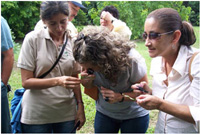 was the first time that many participants attended a workshop on IPM and used microscopes and other equipment.
was the first time that many participants attended a workshop on IPM and used microscopes and other equipment.
Other impacts are: 50% of participants indicated they were better able to identify beneficial insects and described their skill as good or excellent. 40% stated they would now scout for insects prior to applying pesticides. 90% stated their ability to do their job had improved. All of the participants stated the IPM program was beneficial to them and the scouting kit would be useful on their job.
Click here to view the first year of this IPM Program, Part 1 - Year 2007.
Project leaders:
- Henry Mayer, Commercial Urban Horticulture Agent, UF/IFAS Miami-Dade Cooperative Extension Service
- Ed Skvarch, Commercial Horticulture Agent, St. Lucie County Extension
- Rebecca Jordi, Horticulture and Environmental Agent, Nassaau County Extension